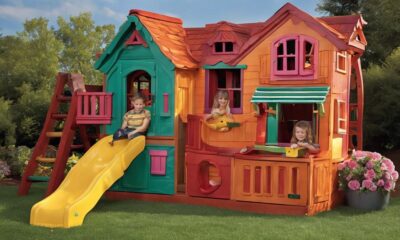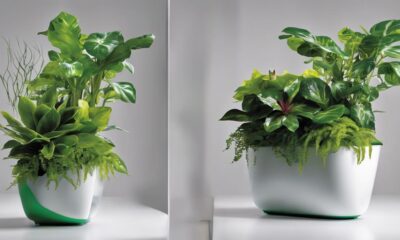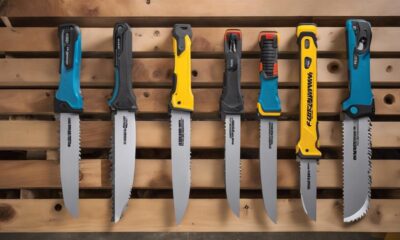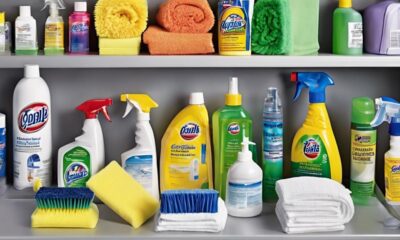Beginners Guides
Difference Between Indoor and Outdoor Ceiling Fans

Have you ever thought about how the location can affect how well a ceiling fan works? When deciding between indoor and outdoor ceiling fans, there are many things to consider.
From the design and construction to the performance and installation, each type serves a unique purpose. As we explore the key differences, you'll gain valuable insight into the considerations that can greatly influence your decision.
Key Takeaways
- Energy efficiency is crucial for determining the suitable fan type for a location, with indoor fans optimizing energy efficiency for enclosed spaces and outdoor fans built to withstand weather conditions while maintaining energy efficiency.
- Design and construction variations cater to specific environments, with indoor fans prioritizing aesthetic appeal and blending seamlessly into interior decor, while outdoor fans focus on durability and weather resistance.
- Blade material and finish differences are significant, with indoor fans commonly featuring wood, MDF, or plastic blades for aesthetic appeal and quiet operation, while outdoor fans require ABS plastic, stainless steel, or treated wood blades to withstand outdoor elements.
- Motor and performance variability also differ between indoor and outdoor fans, with indoor fans designed for energy efficiency and quiet operation, while outdoor fans prioritize durability and resistance to weather conditions, often having a more robust build and enhanced airflow capacity.
Location and Environment Considerations
When choosing between indoor and outdoor ceiling fans, it's essential to consider the specific location and environmental factors that will impact the fan's performance and longevity. Firstly, energy efficiency is a crucial consideration when determining the type of ceiling fan suitable for a particular location. Indoor ceiling fans are designed to optimize energy efficiency for enclosed spaces, whereas outdoor fans are built to withstand varying weather conditions while maintaining energy efficiency. Understanding the energy efficiency of each type will help maximize cost savings and environmental sustainability.
Additionally, air circulation is a key factor influenced by the location of the fan. Indoor fans are tailored to circulate air in a consistent and controlled manner within a room, while outdoor fans are engineered to withstand outdoor elements and provide adequate air circulation in open spaces. The differences in design cater to the unique air circulation requirements of each setting, ensuring optimal comfort and ventilation.
Design and Construction Variations

Considering the energy efficiency and air circulation differences between indoor and outdoor ceiling fans, it's important to note the distinct design and construction variations that cater to their specific environments.
Design options for indoor ceiling fans often prioritize aesthetic appeal, with a focus on blending seamlessly into interior decor. They're typically available in a wide array of styles, finishes, and sizes to complement different room designs.
In contrast, outdoor ceiling fans are designed with a focus on durability and weather resistance. Material selection is crucial for outdoor fans, with options such as stainless steel, ABS plastic, or specially treated wood to withstand moisture, heat, and other outdoor elements.
When it comes to energy efficiency, both indoor and outdoor fans can be designed with this in mind. Indoor fans may include features such as LED lighting, DC motors, and blade designs optimized for efficient airflow.
Outdoor fans, on the other hand, may incorporate features like sealed motors and all-weather blades to ensure they operate efficiently and reliably in outdoor settings.
Blade Material and Finish Differences
In comparing the blade material and finish differences between indoor and outdoor ceiling fans, it's essential to recognize the distinct requirements for each setting.
Blade material plays a crucial role in the functionality and durability of ceiling fans. Indoor fans commonly feature blades made from wood, MDF, or plastic, which are chosen for their aesthetic appeal and quiet operation.
On the other hand, outdoor ceiling fans require blades crafted from materials such as ABS plastic, stainless steel, or treated wood, designed to withstand exposure to moisture, heat, and humidity, ensuring longevity and performance in outdoor environments.
Finish options also vary between indoor and outdoor ceiling fans. Indoor fans often showcase a wider range of finishes, including various wood stains, painted or lacquered blades, and metallic finishes to complement interior décor.
Conversely, outdoor fans are typically equipped with finishes that are resistant to rust, corrosion, and UV damage, such as powder-coated or galvanized finishes, ensuring the fan's ability to withstand outdoor elements.
Understanding the differences in blade material and finish options between indoor and outdoor ceiling fans is crucial in selecting the most suitable fan for each environment.
Motor and Performance Variability

Our evaluation of motor and performance variability in indoor and outdoor ceiling fans revealed significant differences in their design and functionality. Understanding these disparities is crucial for selecting the right fan for specific environments.
Here's what we found:
- Motor Efficiency: Indoor ceiling fans are designed with motors optimized for energy efficiency and quiet operation. They're engineered to deliver consistent performance while consuming minimal electricity. On the other hand, outdoor ceiling fans are built with motors that prioritize durability and resistance to varying weather conditions. This often results in slightly lower energy efficiency compared to indoor fans.
- Airflow Capacity: Indoor ceiling fans are tailored to circulate air within a controlled environment, focusing on maximizing airflow efficiency. In contrast, outdoor ceiling fans are engineered to withstand outdoor elements while maintaining optimal airflow capacity. This often leads to a more robust build and enhanced airflow capacity to effectively circulate air in open spaces.
- Performance Adaptability: Indoor ceiling fans are adept at providing comfort in indoor settings, with features tailored to complement interior design and maintain a pleasant atmosphere. Outdoor ceiling fans, however, are designed to perform reliably in outdoor environments, often incorporating features such as enhanced moisture resistance and UV protection to ensure longevity and sustained performance.
Understanding the nuanced differences in motor efficiency and airflow capacity between indoor and outdoor ceiling fans is essential for making informed purchasing decisions.
Installation and Maintenance Requirements
With careful attention to installation and regular maintenance, both indoor and outdoor ceiling fans can provide optimal performance and longevity.
When installing a ceiling fan, it's crucial to ensure that it's securely mounted to a ceiling joist or support brace to prevent wobbling and potential safety hazards. For outdoor fans, it's important to choose models specifically designed for outdoor use, as they're constructed to withstand moisture, humidity, and varying temperatures. Additionally, it's advisable to consider the energy efficiency of the fan by choosing models with the ENERGY STAR label, which can help reduce utility costs.
In terms of maintenance, a regular schedule should be established for cleaning the fan blades and motor housing to prevent dust buildup, which can affect performance and increase noise levels. It's also important to check and tighten any loose screws or connections to minimize vibrations and noise. For optimal energy efficiency, consider using a ceiling fan with adjustable speed settings and installing it at an appropriate height for the room.
Following these installation tips and maintenance schedules can ensure that both indoor and outdoor ceiling fans operate efficiently and quietly, providing comfort and cost savings.
Frequently Asked Questions
Are Indoor and Outdoor Ceiling Fans Interchangeable or Can They Be Used in Both Environments?
Yes, indoor and outdoor ceiling fans aren't interchangeable due to their differing installation requirements and compatibility.
Indoor fans are designed for controlled environments and may not withstand outdoor conditions.
Outdoor fans are built to withstand moisture and are designed for outdoor aesthetics.
Installing an indoor fan outdoors could lead to safety hazards and damage.
It's crucial to choose the right fan for each environment to ensure optimal performance and safety.
Can Outdoor Ceiling Fans Be Used in Covered Outdoor Spaces, Such as a Screened-In Porch or Patio?
Yes, outdoor ceiling fans can be used in covered outdoor spaces, like screened-in porches or patios. When considering installation requirements, it's important to ensure that the fan is designed for damp or wet locations.
Design options for outdoor fans include weather-resistant materials and finishes. These fans are built to withstand the elements and provide comfort in outdoor settings, making them a great choice for covered outdoor spaces.
Are There Specific Safety Considerations for Outdoor Ceiling Fans That Are Not Relevant for Indoor Fans?
When it comes to safety considerations for outdoor ceiling fans, we need to pay attention to installation requirements and maintenance tips.
Unlike indoor fans, outdoor fans need to be weather-resistant, like a sturdy ship in a storm. It's crucial to ensure proper installation to withstand outdoor elements.
Additionally, regular maintenance checks are essential to keep the fan running smoothly and safely.
These factors are crucial to consider when choosing and using outdoor ceiling fans.
What Are the Differences in Energy Efficiency Between Indoor and Outdoor Ceiling Fans?
When comparing the energy efficiency of indoor and outdoor ceiling fans, the motor design, blade material, and airflow direction play crucial roles.
Efficient motor design and optimized blade materials contribute to energy savings.
Additionally, considering the airflow direction for each setting ensures maximum efficiency.
This knowledge is essential for mastering the differences in energy efficiency between indoor and outdoor ceiling fans.
Can Outdoor Ceiling Fans Be Used in Areas With High Humidity or Saltwater Exposure?
Absolutely, outdoor ceiling fans can handle high humidity and saltwater exposure. They're designed with robust rust resistance and motor protection. This ensures they can withstand harsh outdoor conditions and still operate efficiently.
These features make them perfect for areas with high humidity or saltwater exposure, providing a reliable cooling solution. So, you can trust outdoor ceiling fans to keep you comfortable, even in challenging environments.
Conclusion
In conclusion, when comparing indoor and outdoor ceiling fans, it's clear that location and environment considerations, design and construction variations, blade material and finish differences, motor and performance variability, and installation and maintenance requirements all play a pivotal role in their differences.
From beach bungalows to cozy cabins, each fan fulfills specific needs. So, whether indoors or outdoors, choose wisely to keep cool and comfortable in any climate.
- About the Author
- Latest Posts
Introducing Ron, the home decor aficionado at ByRetreat, whose passion for creating beautiful and inviting spaces is at the heart of his work. With his deep knowledge of home decor and his innate sense of style, Ron brings a wealth of expertise and a keen eye for detail to the ByRetreat team.
Ron’s love for home decor goes beyond aesthetics; he understands that our surroundings play a significant role in our overall well-being and productivity. With this in mind, Ron is dedicated to transforming remote workspaces into havens of comfort, functionality, and beauty.
Beginners Guides
Does a Ceiling Fan Use a Lot of Electricity?


To determine the electricity usage of a ceiling fan, multiply the watts by the rate of one kilowatt-hour (as indicated on your most recent electric bill). One kilowatt is equivalent to the cost of operating a ceiling fan for one hour. Using the fan daily will result in approximately one kilowatt per hour.
Ceiling fan with lights: How much to pay?
How long a ceiling fan is running will affect how much it costs to operate. A fan of average size consumes approximately 40 kilowatts per hour. The annual cost of the fan is $44. If you only use the fan for a few hours per day, however, it can be very cost-effective to run a ceiling fan.
Extra wiring is required for a ceiling fan equipped with lights. Without installation, the electrician’s cost will range from $150 to $300. If you prefer to do DIY, a handyman can install your ceiling fan at $75. Before installing a ceilingfan, you will need to have your electrician inspect your circuit panels. Because the fan will place a lot of strain on your breakers, Incorrect wiring can also lead to zone crossovers.
There are many factors that affect the cost of operating a ceiling fan with lights. These factors include the size of the fan and its energy efficiency. Although the fan’s wattage might be low, the lights will still require additional electricity. Ceiling fans equipped with LED lights will cost less than regular light bulbs. When you leave a room, turn off the fan.
Ceiling fan running at full speed: Cost to run
The cost to run a ceiling fan at maximum speeds will depend on your local electricity tariff. One cent is charged for each kilowatt hour of electricity consumed by a fan. This information can be found on the instruction leaflet for your fan or on the fan itself. To get the actual cost, divide this number by 1,000.
Ceiling fans use very little power, making them energy-efficient. They use half the electricity of traditional light bulbs and are therefore less energy-intensive. Modern fans consume between fifty and one hundred Watts of power to operate, which is lower than older models. Ceiling fans should run at lower speeds.
To enable a 100-watt ceiling fan at full speed, you’ll need to pay $3 per month in electricity. This could add up over a year to $40. A ceiling fan can be used at a low speed to lower your electric bill.
Ceiling fan at low speed
Although you may not be aware of it, running a ceiling fan at a low speed can help you save money on electricity. The average ceiling fan consumes six cents an hour of electricity, so running it at a lower speed could save you money. The kilowatt hour (kWh) rating determines how much electricity your ceiling fan uses. The kWh rating determines how much you will be charged per hour.
Ceiling fans work extremely well. Ceiling fans consume 50 watts on average. This is lower than a 60-watt incandescent light bulb. You should be concerned about how much electricity your fan consumes if it is running at high speeds. To reduce your monthly energy costs, an ENERGY STAR-certified fan can be used. If you select this fan, you can also purchase an extended warranty.
Ceiling fans are a great way to reduce your energy consumption, but be aware of the wattage rating. The wattage of a ceiling fan can be used to determine its wattage at lower speeds. The best way to cool your house is with a ceiling fan that runs at low speeds. AC conditioners require more powerful motors and are more expensive to run.
- About the Author
- Latest Posts
Meet Bethia, the visionary designer at ByRetreat who brings a touch of magic to every remote workspace she creates. With a boundless imagination and an eye for beauty, Bethia is passionate about transforming ordinary spaces into extraordinary havens of creativity and comfort.
Bethia possesses a unique talent for envisioning the perfect combination of furniture, colors, and textures that harmonize seamlessly in a room. She understands that selecting furniture goes beyond mere functionality; it’s about curating pieces that evoke a sense of style and sophistication while enhancing the overall ambiance.
Beginners Guides
Are Bigger Ceiling Fans Better?

Ceiling fans are a common choice for cooling a room. Are larger fans more effective? This blog will explore the advantages and disadvantages of installing a bigger ceiling fan in your home. Stay cool!

Ceiling fan size
When buying a ceiling fan, it is essential to think about the space. You should allow at least two to three feet between your ceiling fan and the closest wall. You may need to allow more clearance if your ceiling is too high. Consider not purchasing a large ceiling fan if your room has a high ceiling.
Ceiling fans are divided into multiple categories. Blade diameter is one of them. This is even more important than the number of blades. It measures from the tip of one blade to the other. It is important to note that ceiling fans do not have an even number. The majority of fans usually have three to five blades. The circumference of a ceiling fan circle is the distance between one blade‘s tip and its opposite tip.
Number of blades
In choosing a ceiling fan, the number of blades will be a major factor. This can impact the airflow and noise levels. For large industrial fans, there are often three or more blades. This allows for the movement of large volumes of air while making minimal noise.
You should think about the number of blades when buying a ceiling fan to lighten a larger space. Ceiling fans with more than four blades won’t circulate as much air. Fans with 3 or fewer blades will still produce the same airflow.
Rating CFM
Choosing a ceiling fan is crucial. This rating indicates how much air the fan can move within 60 seconds. CFM is a measure of how much air the fan can move in 60 seconds. This is only one aspect to consider when choosing a fan. Important factors are the motor and blade pitch.
Ceiling fans with a higher CFM rating can move more air. Because the fan blades are wider, a larger fan can distribute more air throughout a room. Air is circulated behind fan blades, making it easier to reach larger areas. A higher CFM rating will reduce the amount of wind blowing in your room.
Style
The Big Ass Fan Company makes large-diameter, industrial-style ceiling fans. The fans typically span between 84 and 99 inches. These fans come in a variety of sizes and can have different numbers of blades. The size of your room will depend on what you need and your aesthetic preferences.
Big ceiling fans can be a great choice for open-concept rooms. These fans can be used to provide air circulation, which is an advantage in large rooms.
Space is required
Take into account the space needed for ceiling fans to work effectively. The fan will need more space if it is more extensive. It is also essential to consider the distance between fan blade tips and nearby objects. If you don’t have enough space, your ceiling fan may be smaller.
Cost
A larger ceiling fan may be more expensive than a regular one. They can be as low as $50 up to $4,000. They can cost anywhere from $50 to $4,000. Ceiling fans have five to six blades and hang parallel to the ceiling. Remote control and light fixture are often included. Many models include extra features such as multiple speeds or variable speeds.
For your home decor, larger ceiling fans can make a statement. Because they have larger blades, they can move more air per minute and provide better air circulation. They can also be less expensive to run than traditional models. More giant ceiling fans run with DC motor technology. This means that they consume less energy than smaller models.
- About the Author
- Latest Posts
Meet Bethia, the visionary designer at ByRetreat who brings a touch of magic to every remote workspace she creates. With a boundless imagination and an eye for beauty, Bethia is passionate about transforming ordinary spaces into extraordinary havens of creativity and comfort.
Bethia possesses a unique talent for envisioning the perfect combination of furniture, colors, and textures that harmonize seamlessly in a room. She understands that selecting furniture goes beyond mere functionality; it’s about curating pieces that evoke a sense of style and sophistication while enhancing the overall ambiance.
Beginners Guides
Creative Ways To Store Your Purses In The Back Of Your Closet

A fantastic method for organizing your handbags is by storing them on shelves. There are various ways to keep your purses neat and tidy. Acrylic bins are a popular option.

Pegboard
You can make your purse-storage system with a few items that you can buy at your local hardware shops, such as hooks or pegboard. You can organize your purses in many different sizes. Pegboard can be stacked and painted to match your space.
Another great option is a purse cabinet. This cabinet is basically a bookcase with glass doors. This bookcase organizes your purses well and keeps dust out. A cubby bookcase can be purchased with either eight cubbies or one flat shelf.
Acrylic magazine holders
Clear magazine holders are a smart way to organize your purses. Clear dividers keep purses organized and prevent them from getting lost on the shelf. These dividers can also be used to organize your luggage. Clear dividers are easy to clean.
You can also use magazine holders for other purposes. You can use them to organize office supplies. Magazine holders are ideal for organizing papers and files. They can be stacked vertically on top one another. Acrylic magazine holders can also be used for holding snacks and drinks.
Another creative way to store purses is with a storage bin. These bins can be used to organize multiple collections. You can find one at Urban Outfitters and the Container Store. You can also use hooks to hang purses outside of the closet. Another option is to hang bags from outside the closet with a seashell hook by Urban Outfitters.
Baskets made from fabric
To store your purses, you can also use a spare shelf. You can place the bookshelf inside or outside of your closet. Larger bags can be stored as well as smaller items like handbags. Inserts are a great way to keep large bags in their original form. Designer bags can be protected with dust covers.
You can organize your purses by season. This will allow you to increase your closet space. You can store out-of-season purses in your attic, or another storage space. Clear PVC covers protect purses against dirt and dust as they are stored.
Hanging organizers
First, decide where you want your purses to be kept. You can organize your purses with shelves or dividers. Hanging purse organizers are another way to organize your purses. These organizers can be attached to doors or mounted on the wall. They are easy to reach when you need them. Large purses can be hung from hooks.
Another creative way to store purses is to hang them on wire racks. Hang them from your closet door, or anywhere else you like. Clear acrylic dividers can be a great way of organizing your purses. If you don’t feel like hanging your purses from the back, you can store them on shelves with acrylic shelf separators.
To stuff bags, use newspaper
When storing purses in the back of a cupboard, make sure they look clean and neat. You can stack handbags on shelves or place them in bag stands. Handbags may require additional storage. If you don’t like the way your purse looks, you can stuff it with newspaper remnants or acid-free paper towels. Avoid putting newspaper into your purse, as it can transfer ink onto your lining.
It can be hard to organize your purses if your closet is small. You might consider placing your bags on shelves if you have a large closet. It will be easier to find them if you stack them straight. You can place them in an acrylic bin with shelf dividers. Label each compartment to make it easy to find your purses, no matter where they are kept.
- About the Author
- Latest Posts
Introducing Ron, the home decor aficionado at ByRetreat, whose passion for creating beautiful and inviting spaces is at the heart of his work. With his deep knowledge of home decor and his innate sense of style, Ron brings a wealth of expertise and a keen eye for detail to the ByRetreat team.
Ron’s love for home decor goes beyond aesthetics; he understands that our surroundings play a significant role in our overall well-being and productivity. With this in mind, Ron is dedicated to transforming remote workspaces into havens of comfort, functionality, and beauty.
-

 Vetted1 hour ago
Vetted1 hour ago15 Best Boxwood Varieties for Thriving in Full Sunlight
-

 Vetted3 days ago
Vetted3 days ago15 Best Ways to Label Clothes for Nursing Home Residents – Stay Organized and Efficient
-

 Vetted1 day ago
Vetted1 day ago15 Best Dryer Vent Hoses to Keep Your Laundry Room Safe and Efficient
-

 Vetted1 day ago
Vetted1 day ago15 Best Spider Sprays to Keep Your Home Arachnid-Free
-

 Vetted2 hours ago
Vetted2 hours ago14 Best Cleaners for Aluminum Surfaces – Shine Bright Like a Diamond
-

 Vetted1 day ago
Vetted1 day ago15 Best Nightstand Charging Stations to Keep Your Devices Organized and Ready to Go
-

 Vetted3 days ago
Vetted3 days ago15 Best Beer Fridges to Keep Your Brews Cold and Ready to Enjoy
-

 Vetted1 day ago
Vetted1 day ago15 Best Outdoor Playhouses That Will Transform Your Backyard Fun



























